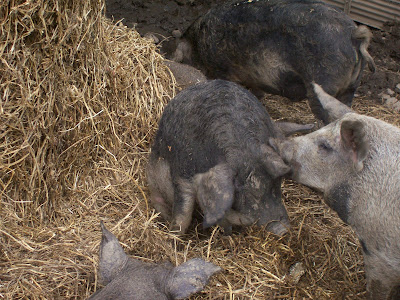
By now many of you have heard of or worked with the heritage breed of hog known as Berkshire. Berks have become popular in many quality kitchens and the popularity seems to grow every year. Berkshire is to pork what Angus is to beef, quality breeds that produce quality meat. So what else is  out there? Specialty farmers have been trying a variety of heritage breed hogs here in the Northeast for the past 15 or 20 years. Breeds such as the Tammworth, Old Spots, Hampshires, Durocs have all found their way to various farmer's markets. Most are raised by small farmers who allow the pigs some freedom and feed them with a variety of stuffs such as locally grown corn, apples, old pumpkins and squash, acorns, and a huge variety of kitchen scraps.
out there? Specialty farmers have been trying a variety of heritage breed hogs here in the Northeast for the past 15 or 20 years. Breeds such as the Tammworth, Old Spots, Hampshires, Durocs have all found their way to various farmer's markets. Most are raised by small farmers who allow the pigs some freedom and feed them with a variety of stuffs such as locally grown corn, apples, old pumpkins and squash, acorns, and a huge variety of kitchen scraps.
 out there? Specialty farmers have been trying a variety of heritage breed hogs here in the Northeast for the past 15 or 20 years. Breeds such as the Tammworth, Old Spots, Hampshires, Durocs have all found their way to various farmer's markets. Most are raised by small farmers who allow the pigs some freedom and feed them with a variety of stuffs such as locally grown corn, apples, old pumpkins and squash, acorns, and a huge variety of kitchen scraps.
out there? Specialty farmers have been trying a variety of heritage breed hogs here in the Northeast for the past 15 or 20 years. Breeds such as the Tammworth, Old Spots, Hampshires, Durocs have all found their way to various farmer's markets. Most are raised by small farmers who allow the pigs some freedom and feed them with a variety of stuffs such as locally grown corn, apples, old pumpkins and squash, acorns, and a huge variety of kitchen scraps. Enter the Mangalitsa breed, a heritage breed from Austria/ Hungary. My grandfather Karl Schneller grew up in the southeastern portion of Austrian, near the Hungarian border. My Aunt Mary was born in Hungary and our family has a long food history that maintains many of the specialties from that area of the world. My father would make Speck in his butcher shop that was the same as my Austrian grandfather made. The Mangalitsa is a breed of hog from this part Europe. It is considered by many as the best tasting pork in Europe and is prized for its fat. It is unique in that it has a thick sheep-like wooly coat and does very well in colder climates. In 2006 a entrepreneur, Heath Putman, brought some breeding stock to the US and started the company Wooly Pigs http://woolypigs.com/index.html Wooly pigs is located in the state of Washington and they have recently sold some stock to Mosefund Farm http://mosefund.com/ in northern New Jersey, about an hour and a half drive to the CIA in Hyde Park. Michael Clampffer , CIA alumni, manages the raising of hogs and is involved with selling the meat to chefs in NYC.

On Saturday my nephew Austin and I met up with my teaching assistant Steven Bookbinder and his girlfriend at the Mosefund farm to ask some questions and see the old/ new breed. Austin raises a few hogs each year in Stone Ridge NY and this year he has a Berk, a Hampshire and a crazy mixed breed that is part Duroc. Both of us hadn't seen anything like the Mangalitsa. Michael was an excellent host and answered our many questions about feed and raising techniques. He explained that some of the forty or so hogs were either purebred or crossed with Berkshire. The smaller pigs were all 75% Mangalitsa and 25% Berk. They are fed restaurant scraps, and a mixture of barley and wheat. They are allowed to graze on fields of chickory and clover from time to time which they destroy in hours! Like most heritage hogs, they love to root and dig.
Mangalitsa has been praised in articles recently in the NYTimes and Saveur to name a couple. It is touted as the best tasting pork and has a fat that is lower in saturated fat. Don't be mistaken. It is not a low fat pork but the fat is higher in monosaturated fat as opposed to most pork on the market.
Michael wanted us to experience the pork so we received a fresh ham and I broke it down into subprimals and tied some roasts. While cutting it I trimmed some of the fat and rendered it. I also cut a small steak off the sirloin side and panseared it with nothing but salt and pepper. It was very nice! I gave a slice to my 16 yearold son who also knows something about pork and he said only one word which tells the the story "Good".

Michael will attend a demo, lecture and tasting featuring the pork at the CIA this fall and he will be hosting the president of the Austrian Mangalitsa Society this coming winter for a three day seminar demonstrating traditional cutting styles and curing techniques.
As we as a food society constantly search for the best flavors it is exciting for me to find a hog that I never knew existed gaining in popularity. Mosefund farm is located in north Jersey which is very much like the foothills of the Catskills where I live and the hogs are in the shade of a beautiful mountain side, like somewhere in Austria. 








